Real Flight 175 was template for Hologram

Yep. In order to pull of such a heinous stunt and have the capability to cover it up until the perpetrators are all dead... they used THE BEST TECHNOLOGY, just like the best illusionist would. And just like the best illusionists, the trick-technology is quite safe amongst fellow illusionists.

In Hezarkhani's video we see a CGI-plane disappearing inside the building in the same way that a knife goes through warm butter. That cannot be reality.
BUT THERE WAS NO PLANE!
Charlie Rose program as aired on 10/31/01 on PBS at:
http://www.youtube.com/watch?v=B3HCwJhZaY0
Quote:
|
Quote:
|
I re-investigated the technology behind the hologram that "crashed" into the Word Trade Center. I know the technology must be REAL TIME HOLOGRAHY and the physics are known well. However, the (top secret!) technology must be powerful and from 1999 or so.
And then it occured to me!!
Remember the low flying big jet flying over New York just prior to the "wtc 2 ua 175 impact"? OF COURSE!!
Remember "amputee planes" and my 911 Variable VISIBILITY HOLOGRAMME THEORY???
CHECK OUT the Luc Courchesne VIDEO

![[image]](http://www.olats.org/projetpart/artmedia/2002/img/courchesne1.jpg)
Killtown's: WTC Crash Videos
And then there is the NOSE OUT:

Simple explanation: The laser illuminator was still powered-on!!
The simply did not expect that the missile carrying the projection-screen would exit the WTC building on the other end and the projection-vapor would still create an opaque image. (The technology is TRUELY ROBUST! ;-)
You can see the laser projector in theDavid Thom pictures
more explanation: HOLO-TVF ...
How they did the gash? kinetic weapons!

http://www.gallerize.com/9-11/TOTL/05.htm
So where did the engine come from?

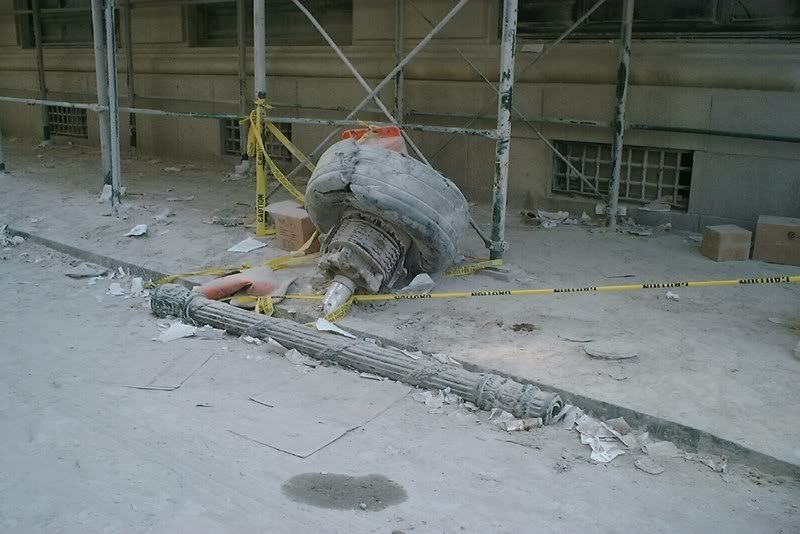 | 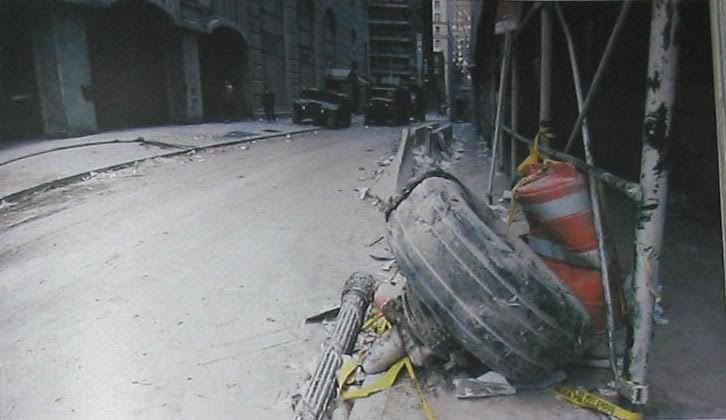 |
| Figure 25(a): Landing gear amid dust, adjacent to old scaffolding, not on a street corner, close to curb, just left of the mid-point of a dusty Greco-Roman pillar lying in the gutter. | Figure 25(b): Landing gear amid dust, adjacent to old scaffolding, not on a street corner, close to curb, just left of the mid-point of a dusty Greco-Roman pillar lying in the gutter. The crime-scene ribbon is oriented differently and the axel hanging over the curb more than in Fig. 25(a). [cut from this picture.] |
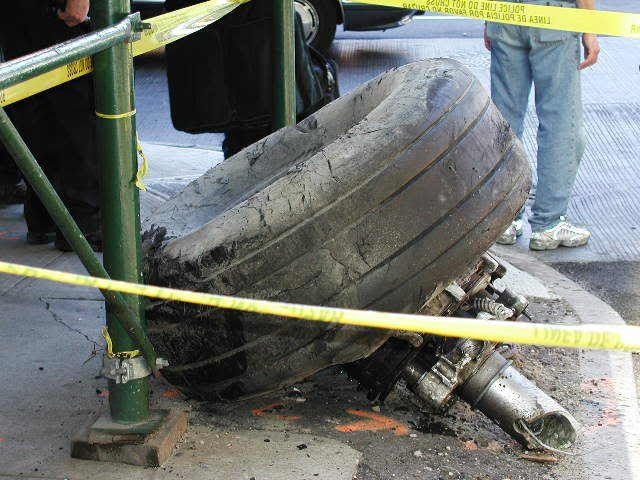 | 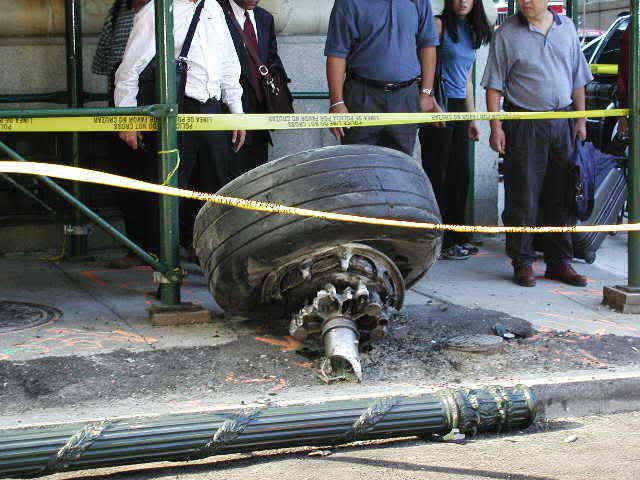 |
| Figure 25(c): Landing gear on a dust-free street corner near shiny new scaffolding, set back from the curb and no Greco-Roman pillar visible. The tire and brakes look different too. Note the failure surface of the shaft. It's sharp, not appearing to have bounced around on the pavement. It also appears to be a torsion failure. How can an explosion cause that? | Figure 25(d): Landing gear in new photo op: tire looks in better health, no extensive dust, new scaffolding, further from the corner, further forward toward the top of a dust-free Greco-Roman pillar. We suspect tampering with evidence J . Actors gape (no one walking on their way, a suitcase on the morning of 9/11?) at nice tire and shiny shaft, wondering why the tire, brake housing and shaft would be unburned despite ejection through a "jet fuel conflagration" high atop a tower. |
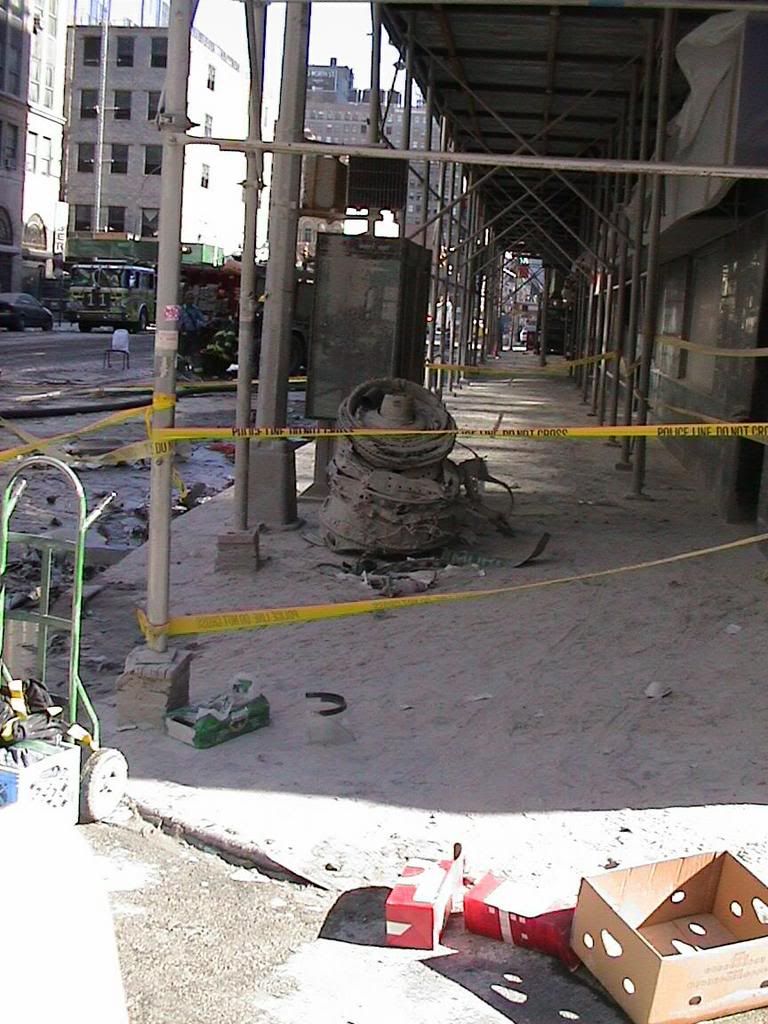 | |
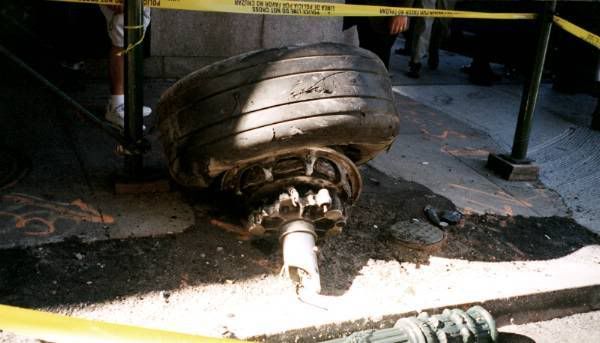 | |
| Figure 25(e): This piece also has an affinity for canopy-covered scaffolding. | Figure 25(f): And yet another view. |
Scrutiny of alleged eyewitness testimony, however, may not be entirely worthless. As far as we can tell, there is a dearth of testimony from disinterested witnesses affirming airliner flights into the WTC towers. Consider the first plane that allegedly flew into the North Tower: many thousands of people in Central Park plus northbound drivers, passengers and pedestrians along First, Second and Third Avenues, Lexington Avenue, Park Avenue, Madison Avenue, Fifth Avenue, Avenue of the Americas, Broadway, etc., would have seen a low-flying AA Boeing 767 thundering south/southwest down the island of Manhattan. At high speed it would have been incredibly noisy, extraordinary and scary. It would have echoed down the canyons. The direction or source may not have been obvious at first. At 400+ mph the jetliner would have taken approximately one minute to fly less than seven miles from just north of Central Park into the North Tower, plenty of time for witnesses to see and track a plane go by but not hit the tower. Thousands of disinterested eyewitnesses could have confirmed a Boeing 767 flying overhead if the official story were true but I’ve not seen such interviews. The internet lacks credible "street interviews" and the controlled media did not go there. That is a telling fact.
The witnesses offered are usually media people.. see September Clues VCD (911 TV Fakery)
But here now the article that inspired me this morning...
Holography - Real-time holography
The discussion above describes "conventional" holography, whereas the steps of recording, developing and reconstruction are performed independently or at different times in sequence. Also, the recording medium for conventional holography is typically film so that the hologram is permanently formed. This static recording notion is, in fact, similar to a photograph, which is also a permanent recording of image information. Thus, once formed, the hologram is "fixed," or unchangable.
Beyond conventional holography, there exists a technique whereby all the steps used to form a hologram are performed simultaneously in a material that can be refreshed. That is, the steps of recording, developing and reconstruction all take place at the same time (not sequentially). Moreover, the material used for this novel hologram is not film, but a material with properties which allow continuous updating of the hologram making the hologram dynamic so that the image information which records the hologram can change and the reconstructed output can also track, or change, simultaneously.
Such a dynamic hologram is called a "real-time hologram." The material that replaces film must also be capable of changing in response to a varying set of recording beams and input image information. Examples of such materials are referred to as "nonlinear optical materials," and can be realized using a variety of media such as photorefractive crystals, atomic vapors and gases, semiconductors (including "quantum wells"), plasmas and, even liquids. In this case, the local absorption and/or phase in the nonlinear material will be "exposed," and will "track" changes in the interference pattern formed by the recording beams. As the interference pattern changes, the local absorption and/or phase pattern in the material will also change and replace the original pattern. Beyond these "passive" materials, the dynamic media can also be in the form of "active" electro-optical devices, such as spatial light modulators (SLMs). In this case, the pixelated image-bearing input port serves as the "dynamic recording material," whereas the pixelated output of the device (e.g., the output display, or projection port) functions as the effective holographic reconstruction port. Currently, SLMs involve the use of liquid crystal layers as well as micro-electrical mechanical (MEMS) technologies as the pixelated image-bearing output (projection) port. The pattern imposed onto the input port of the SLM will give rise to a corresponding output pattern, as read out by the reconstruction beam. By virtue of the SLM, the output, or reconstruction, beam will be spatially encoded as a corresponding amplitude, phase or polarization pixelated mapping of the input image.

Around 36 "private" videos exist of a plane hitting WTC-2, all of them excluding one anothers genuineness. Here we see frames from Michael Hezarkhani's video
Carmen Taylor and M. Hezarkhani stood side-by-side on a ferry boat in Battery Park
The speed, or, frame-rate, of such real-time media -- that is, the number of independent holograms that can be formed, erased, updated and reconstructed by this process -- can be in the range of many seconds to picoseconds of faster. In the case of high-definition (about one million resolvable pixels) high-speed video-rate information (about 1 ms frame rate), this implies an effective optical processing rate of a gigahertz (GHz). In the case of an advanced spatial light modulator (with a frame-rate in the microsecond range), the effective computational rate of a real-time holographic processor can exceed a terahertz (THz).
In the jargon of nonlinear optics, this operation that involves the simultaneous recording and reconstruction of a hologram in a material is referred to as "degenerate four-wave mixing" ("DFWM"). This follows, since there are four optical beams that interact to form the real-time hologram: a pair of recording beams, a readout beam, and, the resultant output, or reconstructed beam. The search for novel nonlinear optical materials for real-time holography is a very active area of present-day research.
Potential applications of such real-time holograms include phase-conjugate mirrors ("time-reversal" of light), optical cache memories, image processing (pattern recognition of time-varying images), and optical computing, among others (see below). As an example, in an outdoor laser communication system across an atmospheric path, one must compensate for atmospheric turbulence (the phenomenon that gives rise to the "twinkling" of starlight as well as beam wander) to enable a high-quality optical channel to exist. That is, without such atmospheric compensation, the optical receiver at the end of the link cannot distinguish between useful data transmission (such as modulation of the laser beam) and that of the random "twinkling" of the laser beam as it propagates from the sender to the receiver. By using a real-time hologram to form a "phase-conjugate" mirror at one or both ends of the link, the effects of atmospheric turbulence can be "undone" ("untwinkling the starlight"), resulting in an optical channel without random noise. Hence, the optical link, even across an atmospheric path, will behave as if the link is established in the vacuum of space, where the stars do not twinkle. In one example, a phase-conjugate mirror with a modulation capability at one end of the optical link, can be used to simultaneously compensate for propagation distortions and encode information (data) to be beamed to the other end of the link. This device is referred to as a "retro-modulator."
The current leader in the development in real time holography is MIT's Spatial Imaging Group, having created machines that allow interactivity between a user and a 3D mid air projected image, such as a virtual lathe.
Holography - References
1. Scientific American, December 1985, "Phase Conjugation," by Vladimir Shkunov and Boris Zel'dovich.
2. Scientific American, January 1986, "Applications of Optical Phase Conjugation," by David M. Pepper.
3. Scientific American, March 1987, "Optical Neural Computers," by Demetri Psaltis and Yaser S. Abu-Mostafa.
4. Scientific American, October 1990, "The Photorefractive Effect," by David M. Pepper, Jack Feinberg, and Nicolai V. Kukhtarev.
5. Scientific American, November 1995, "Holographic Memories," by Demetri Psaltis and Fai Mok.
Holography - Real-time holography: Encyclopedia II - Holography - Real-time holography
The discussion above describes "conventional" holography, whereas the steps of recording, developing and reconstruction are performed independently or at different times in sequence. Also, the recording medium for conventional holography is typically film so that the hologram is permanently formed. This static recording notion is, in fact, similar to a photograph, which is also a permanent recording of image information. Thus, on ...
See also:
Holography, Holography - Overview, Holography - Technical description, Holography - Holographic recording process, Holography - Holographic reconstruction process, Holography - Materials, Holography - Mass replication, Holography - Real-time holography, Holography - References, Holography - Digital holography, Holography - Computer Generated Holographic Cinema, Holography - Holography in art, Holography - Holographic data storage
Holography, Holography - Computer Generated Holographic Cinema, Holography - Digital holography, Holography - Holographic data storage, Holography - Holographic reconstruction process, Holography - Holographic recording process, Holography - Holography in art, Holography - Mass replication, Holography - Materials, Holography - Overview, Holography - Real-time holography, Holography - References, Holography - Technical description
Holography: Encyclopedia II - Holography - Real-time holography
WIKIPEDIA
Dynamic holography
In static holography, recording, developing and reconstructing occur sequentially and a permanent hologram is produced.
There also exist holographic materials which do not need the developing process and can record a hologram in a very short time. This allows to use holography to perform some simple operations in an all-optical way. Examples of applications of such real-time holograms include phase-conjugate mirrors ("time-reversal" of light), optical cache memories, image processing (pattern recognition of time-varying images), and optical computing.
The amount of processed information can be very high (terabit/s), since the operation is performed in parallel on a whole image. This compensates the fact that the recording time, which is in the order of a µs, is still very long compared to the processing time of an electronic computer. The optical processing performed by a dynamic hologram is also much less flexible than electronic processing. On one side one has to perform the operation always on the whole image, and on the other side the operation a hologram can perform is basically either a multiplication or a phase conjugation. But remember that in optics, addition and Fourier transform are already easily performed in linear materials, the second simply by a lens. This enables some applications like a device that compares images in an optical way.[15]
The search for novel nonlinear optical materials for dynamic holography is an active area of research. The most common materials are photorefractive crystals, but also in semiconductors or semiconductor heterostructures (such as quantum wells), atomic vapors and gases, plasmas and even liquids it was possible to generate holograms.
A particularly promising application is optical phase conjugation. It allows the removal of the wavefront distortions a light beam receives when passing through an aberrating medium, by sending it back through the same aberrating medium with a conjugated phase. This is useful for example in free-space optical communications to compensate for atmospheric turbulence (the phenomenon that gives rise to the twinkling of starlight).
Four-wave mixing
is an intermodulation distortion in optical systems, similar to the third-order intercept point in electrical systems.
Four-wave mixing can be compared to the intermodulation distortion in standard electrical systems. When three wavelengths interact in a nonlinear medium, they give rise to a fourth wavelength which is formed by the scattering of the incident photons, producing the fourth photon.
Volumetric display
A volumetric display device is a graphical display device that forms a visual representation of an object in three physical dimensions, as opposed to the planar image of traditional screens that simulate depth through a number of different visual effects. One definition offered by pioneers in the field is that volumetric displays create 3-D imagery via the emission, scattering, or relaying of illumination from well-defined regions in (x,y,z) space.
Although first postulated in 1912, and a staple of science fiction, volumetric displays are still under development, and have yet to reach the general population. With a variety of systems proposed and in use in small quantities — mostly in academia and various research labs — volumetric displays remain accessible only to academics, corporations, and the military.
(The US military did 911. Henry Hugh Shelton must be jailed for life.)
Several static-volume volumetric 3-D displays use laser light to encourage visible radiation in a solid, liquid, or gas. For example, some researchers have relied on two-step upconversion within a rare earth-doped material when illuminated by intersecting infrared laser beams of the appropriate frequencies.
- 3D Technology Laboratories (article) — Uses two crossing infrared lasers to stimulate rare earth impurities in a special glass, which then re-emit visible light photons with the summed energy of the two infrared photons.
Another technique uses a focused pulsed infrared laser (about 100 pulses per second; each lasting a nanosecond) to create balls of glowing plasma at the focal point in normal air. The focal point is directed by two moving mirrors and a sliding lens, allowing it to draw shapes in the air. Each pulse creates a popping sound, so the device crackles as it runs. Currently it can generate dots anywhere within a cubic metre. It is thought that the device could be scaled up to any size, allowing for 3D images to be generated in the sky.
It is often claimed that volumetric displays are incapable of reconstructing scenes with viewer-position-dependent effects, such as occlusion and opacity. This is a misconception; a display whose voxels have non-isotropic radiation profiles are indeed able to depict position-dependent effects. To-date, occlusion-capable volumetric displays require two conditions: (1) the imagery is rendered and projected as a series of "views," rather than "slices," and (2) the time-varying image surface is not a uniform diffuser. For example, researchers have demonstrated spinning-screen volumetric displays with reflective and/or vertically diffuse screens whose imagery exhibits occlusion and opacity. One system (Cossairt et al, 2004; Favalora, 4 Aug. 2005) created HPO 3-D imagery with a 360-degree field of view by oblique projection onto a vertical diffuser; another (Otsuka et al, 2004) projects 24 views onto a rotating controlled-diffusion surface; and another (Tanaka et al, 2006) provides 12-view images utilizing a vertically oriented louver.
So far, the ability to reconstruct scenes with occlusion and other position-dependent effects have been at the expense of vertical parallax, in that the 3-D scene appears distorted if viewed from locations other than those the scene was generated for.
One other consideration is the very large amount of bandwidth required to feed imagery to a volumetric display. For example, a standard 24 bit per pixel, 1024×768, flat/2D display requires about 165 MB/s to be sent to the display hardware to sustain 70 frames per second, whereas a 24 bit per voxel, 1024×768×1024 (1024 "pixel layers" in the Z axis) volumetric display would need to send about three orders of magnitude more (165 GB/s) to the display hardware to sustain 70 volumes per second. As with regular 2-D video, one could reduce the bandwidth needed by simply sending fewer volumes per second and letting the display hardware repeat frames in the interim, or by sending only enough data to affect those areas of the display that need to be updated, as is the case in modern lossy-compression video formats such as MPEG. Furthermore, a 3-D volumetric display would require two to three orders of magnitude more CPU and/or GPU power beyond that necessary for 2-D imagery of equivalent quality, due at least in part to the sheer amount of data that must be created and sent to the display hardware
Actuality Systems Perspecta Volumetric 3D Display
Actuality Systems, Inc. has developed an incredibly high performance three-dimensional display nearly 100 million voxels and interactivity at your fingertips. Professionals in pharmaceutical design, MCAD, and medical imaging can see data floating inside of the clear viewing dome. Your volumetric imagery can be viewed from any angle, without cumbersome goggles.

Perspecta Display 1.9
Actuality Systems is making the 3-D Display compatible with several popular software packaged for molecular visualisation and mechanical CAD. Want to drive the display yourself? The Actuality 3-D Display API is based on Mesa, the open-source graphics library.
The prototype offers both brains and beauty - inside the sleek package is Actuality's custom designed rasterization and processing system crunching your 3-D geometry data with a Texas Instruments™ digital signal processor. A gargantuan 6 gigabits of double data rate SDRAM holds double-buffered R, G, and B channels for the most demanding visualisation work.
Features
- Real, volume-filling 3-D
- 8 vibrant colours
- 768 pixel x 768 pixel x 198-slice resolution
- Nearly 100 million voxels
- Visible by multiple simultaneous users
- 360° horizontal viewing angle
- 180° vertical viewing angle
- Realistic 3-D without goggles

Automatically projects your data into 3-D from many software packages.
The only high-resolution solution for viewing your 3-D information in lifelike, walk-around format.
Transparent viewing dome lets entire design team collaborate.
Small footprint allows the Actuality 3-D Display to fit on your desktop.

HOLOVERSE PRESENTS
Background & Innovations in True Volumetric 3D Imaging
Welcome to the world of Volumetric Imaging where we attempt to create the practical "crystal ball" of the soothsayers -- a volume in which all space and time may be displayed at your command. We have not been alone in this quest but have followed the path of the early pioneers and visionaries. Gauge your analysis by the curl of your thoughts as we venture into the color and charm of the chromosphere.
The Early Pioneers
One of the earliest functional volumetric imagers was this excellent design by Schipper from 1960. It set the standard for the rotating screen technologies which were to follow -- including x-y addressing, a speed control motor, and a stationary enclosure. At the time, high speed light emitters were extremely costly serious hindering the development of large prototype systems for the study of the human visual system response.
| 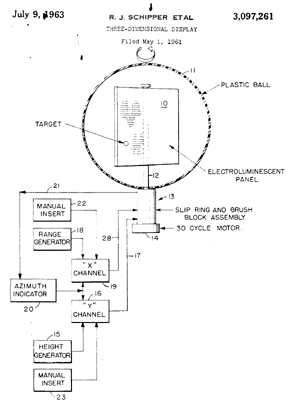 |
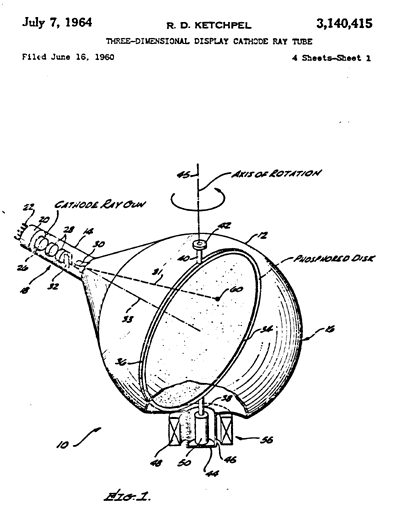 | Ketchpel's 1960 Cathode Ray Tube Imager represents a major step in the integration of television technology and volumetric imaging. Although the electron beam steering technology was at its infancy he clearly anticipated systems which would embody complex, computer-controlled single and multiple guns within an evacuated enclosure. |
Moving to Solid State Systems
| The Swainson Laser Imager in the mid 1970's represents a conceptual breakthrough in volumetric systems. For the first time, the concept of a volume comprised of a homogeneous media and illuminated by intersecting beams was proposed. Swainson enumerated a broad spectrum of excitable composites. | 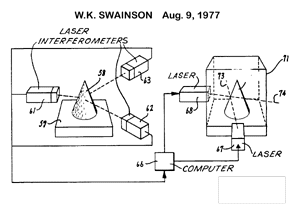 |
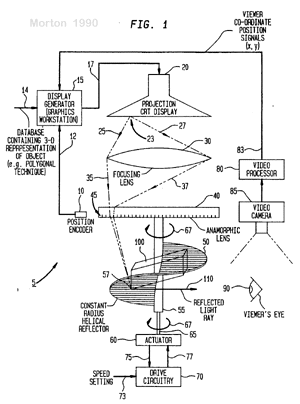 | In 1990, Eastman Kodak researcher, E.L. Morton, devised a method for eliminating the defocusing effect of the change in optical path length in the helical screen volumetric imagers. |
Digital Volumetric Systems
| As a student at MIT in the late 1970's, Edwin Berlin developed a innovative approach to data flow problem which had been constraining early systems. He placed the display electronics on a rotating matrix of light emitters and used a high-speed optical link to connect to the outside world. The technology was exiled from MIT by myopic visionaries. In 1990, Volumetric Imaging licensed the patent and developed a low cost system which displays 1,000,000 voxels simultaneously. | 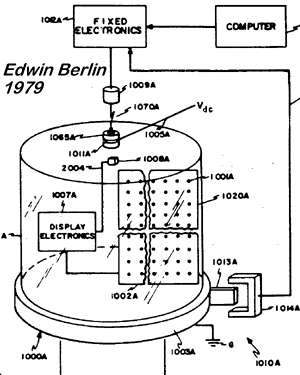 |
Volumetric Imaging Projects
The Volumetric Matrix Imager Model 200
| The Model 200 is a 18" diameter x 36" high Matrix Imager System. All the computational components are contained within the enclosure of aluminum and polycarbonate. This Imager was designed for lower cost experimentation and demonstration. It found success as a research platform in academia and government as well as in the "high art world" when Jenny Holzer chose it as the centerpiece for her Süddeutsche Zeitung exhibit "Lustmord" in 1994. In addition to wide visibility in the European press, the Imager was included in a Sunday New York Times Art Section article on her exhibit. This Model Imager has found a place at SIGGRAPH, trade shows and symposia for general advertising purposes. |
HoloVerse has acquired certain rights to Volumetric Imaging, Inc. technologies including:
Other Volumetric Researchers
- Stanford University
- Texas Instruments
- U.S. Navy
9/11 911 aang accident acoustic amv animals animation anime art ashley asian atheism atheist australia avatar avatar the last airbender awesome babe baby band beach beautiful beer bible bikini bikini news blog blonde blue blues boy brady bush camwithher car cars cartoon cats celebrity challenge christian cliff comedy comment commercial cooking cool cover crash crazy cute dance dancing danny danny phantom death dog dogs drawing drunk dumb eddie entertainment extreme face family fight fighting fire fma food football friend friends fullmetal alchemist fun funny games gay girl girls god guitar hair heather help hilarious horror hot humor humour hunter intro introduction inuyasha iraq japan jazz jen jackson jesus joke katara kid kids kiss kitten kitty leah life live livevideo lol love mad magic model money motorcycle movie music music video naked naruto nes news nintendo nohogirls parody party people pets phantom piano police politics prank productions race racing random rap raven religion robin robot chicken rock sad scary school science sex sexy show silly singer singing snow soccer sokka song south of nowhere spashley spoof sport sports star strip stupid subscribers teen teen titans thong titans toph trailer travel trick truth tv ufo usa video video blog vipor231 vlog war webcam wehogirls weird winter women work world wrestling wtc wwe youtube zuko 2008 abstract Adverse-effects animals autism avian influenza Bioinformatics blog bone books brain breast cancer cancer chemistry Chinese citation citesme classification climate change commentary data mining database de Development differentiation Disease dynamics e-learning EBV evolution expression fish fish oil Free gene expression genome geomorphology guide HIV human information internet IVIG job la language listings literature medical melanoma meningitis method methods migration modern Molecular mouse nanotechnology nature network news online pathology podcast Project publishing research review RNAi robot RSS scholarly communication science scuola semantic web Skin Social Software statistics stress TIC tips to transcription treatment venezia video wavelet wdin.blogspot.com web web2.0 wildlife Wnt 2007 2007 resolution 43 things 43things activism adventure animals appearance art band beauty birthday blog body book books business buy car career celebrity challenge change charity cheers children clean cleaning clothes college communication community computer computers confidence cooking craft crafts create creative creativity culture daily dance design diet discipline disney channel dream dreams eat eating education energy entertainment environment europe exercise experience faith family fashion fear film finance finances financial fitness food football freedom friend friends friendship fun funny future games garden gerard way goal goals god growth guitar hair hannah montana happiness happy health healthy help history hobbies hobby holiday home house independence inspiration internet job joy kids knowledge language languages learn learning life lifestyle literature live living lose weight love marriage mcr me meditation memories mental health miley cyrus mind misspelled goal money movie movies music my chemical romance nature novel organization organize outdoors party passion peace people personal personal development pets philosophy photography photos pictures play poetry politics productivity programming read reading relationship relationships relax relaxation religion romance run running school self self improvement self-improvement sex sexy shopping skill skills sleep social software speling spiritual spirituality sport sports study success technology time travel tv university vacation vegetarian verbose volunteer water web website weight weight loss work world write writing yoga 9-11 advertising america amusing animation apple architecture art astronomy audio australia batshitinsane bbc biology blog blogs books britain bush canada cartoon cartoons censorship children china christianity christmas cinema comedy comics copyright crime culture death design documentary drugs economics education election environment europe evolution fiction film flash flickr food france free fun funny gallery game games gay globalwarming google gop government health history humor humour illustration india internet iran iraq islam israel japan journalism katrina language law life literature london maps marketing math media medicine microsoft military money movie movies mp3 music nasa nature news newsfilter newyork nsfw nyc obit obituary oil painting parody philosophy photographs photography photos physics poetry police politics privacy propaganda protest psychology racism radio religion research rights rock russia satire science sculpture security sex silly space sports technology television terror terrorism torture travel tv uk us usa video videogames war web weird women writing wtf wwii youtube kay parker kayparker noplane911 911taboo nobrainsnoplanes genghis6199 webfairy killtown bsregistration coffinman 911revolution clitorrent livevideo NPT septemberclues socialservice nico haupt 9/11 wtc conspiracy speak rumple we2ru whoiskilltown noplane911 www.911taboo.com http://91taboo.com 911taboo nobrainsnoplanes genghis6199 webfairy killtown bsregistration coffinman 911revolution clitorrent livevideo NPT septemberclues socialservice nico haupt 9/11 wtc conspiracy speak rumple we2ru whoiskilltown 911 9/11 tv-fakery killtown hoax genghis6199 spineymedia bsregistartion 911Revolution

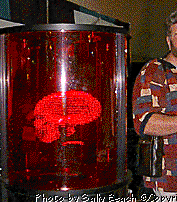
 Earth's magnetic field:
Earth's magnetic field:

0 Comments:
Post a Comment
<< Home